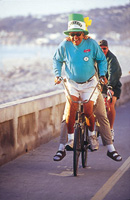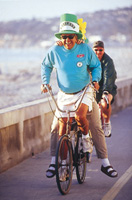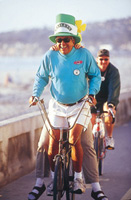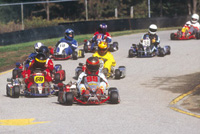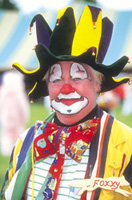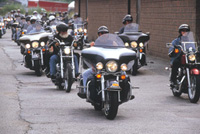Autofocus Problem Solving
10 Tips For Reliable Photography
A full 15 years have passed since the first commercially viable autofocus SLR was introduced (the Maxxum 7000) and the technology has been improved significantly since then. Even so, some photographers consider AF suitable only for snapshooting. Others insist that even the best systems are far from reliable. They relate stories of missed opportunities while the AF system hunted for focus in low light or set focus for an inappropriate subject area. The above may suggest that autofocus is unreliable in general, but that's far from accurate. Having tested numerous autofocus SLR cameras, I know that the current technology is incredibly successful. Photographers with less than perfect vision often consider AF to be a blessing. And the vast majority of professional photographers now admit to using AF in situations where manual focus is too slow for capturing the decisive moment. If you're using an old camera with an outdated AF system, you may not consider autofocus to be as successful. However, most current cameras--with recent AF lenses--provide fast, reliable focus acquisition thanks to new technology and features. These include a wide-area or multi-point AF sensor instead of a single, central sensor with convenient selector controls; effective focus-assist illuminator for low-light photography; superior focus mechanisms in the lenses and camera bodies; and high-speed continuous predictive AF for tracking action subjects. Some models even allow for manually touching up focus while in AF mode. If you're not fully satisfied with the AF performance of your camera, consider the following tips. 1. Don't expect autofocus to read your mind. Even the most advanced and "intelligent" AF system cannot determine your photographic intentions. It's designed to set focus quickly on a reliable target. In a close-up portrait for example, most cameras' AF systems seem to select the nose. In an ultra-wide composition--with subjects at various distances--the system may prefer the nearest object covered by an AF sensor. When shooting an auto race including several competitors, you may find that focus is usually set for the central subject (with a multi-point system), even if the leader is at the side of the pack. |
||||
If these problems lead you to decide that autofocus is "useless," your expectations are unrealistic. While "mind reading" computers may eventually be invented, current technology requires the photographer to take some responsibility. Even eye controlled focus point selection requires some input from the photographer. Instead of using only a point-and-shoot approach, remain aware of the point of focus; when necessary, use one of the AF overrides or techniques. 2. Select the right AF sensor. The multi-point and wide-area AF sensor systems are extremely useful for quick shooting with off-center compositions. Automatic focus point selection (by the camera) can be useful at times: when the important subjects are all at about the same distance from the camera, for example. It may also be fine at a soccer game when a dozen players are included in the frame; then, the specific subject in sharpest focus may not be all that important. Allowing the camera to select the active focus point is also great for continuing to track an action subject when it drifts away from the center of the frame. Naturally, for pinpoint control, it's best to manually select a single focus detection point. With a multi-point AF system, you might select an off-center point if that's where the primary subject is located. Manual focus point selection will ensure focus on your intended subject instead of allowing the system to automatically select another target that is closer to the camera or has higher contrast. |
||||
3. Switch back to the central sensor. With many current cameras' multi-point AF systems, the central focus detection point is the most reliable, since it often employs a cross-type sensor: capable of focusing instantly on patterns of all types. Often, it also has the highest sensitivity in low light and with "slow" (e.g., f/5.6) zoom lenses. If you plan to select a single sensor, it should often be the central point. Achieve focus on the intended subject--or the most important detail--and recompose with focus locked using AF Lock, usually activated with slight pressure on the shutter release button. 4. Avoid static compositions with AF. All too often, photographers switching to an autofocus camera tend to make images with the subject located in the dead center of the frame. This bull's-eye approach leads to static photographs without much viewer appeal. Just because you're using the central sensor to acquire focus, don't forget to keep effective composition a primary goal. (Use AF Lock regularly.) Frankly, photographers who learned their skills with manual focus equipment should not find this to be a problem. The focus aids of their previous cameras were central in the viewing screen. Focusing, and then framing for effective composition, were separate actions, but achieved quickly and subconsciously. The same should apply to using an AF camera's central focus sensor with AF Lock: usually built-into the shutter release button or as a secondary button on the camera or some telephoto lenses. After the system sets focus for the subject, recompose with focus locked. Check a few rolls of your recent photos. Have you fallen into the trap of bull's-eye compositions with autofocus? If so, make a conscious effort to switch to a more effective technique. |
||||
5. Minimize AF frustration in low light. Although a high-tech camera's low-light focusing ability should be very good, even the best systems benefit from thoughtful technique. Use the central focus sensor only and remove filters or accessories that reduce light transmission. If there's a candle or a lamp in the scene, use that as your primary target for focus--if it is at about the same distance from the camera as your intended subject. The camera's focus-assist illuminator lamp is most useful with subjects 15' or less from the camera. For greater distance range, mount an accessory AF flash unit with a more powerful focus-assist illuminator. This projects a more distinct pattern for greater reliability. If you don't plan to use flash, simply switch the unit off before taking the picture. 6. Try problem-solving AF techniques. As your camera instruction manual will indicate, most AF systems cannot easily acquire focus on certain types of subjects. Don't give up if the AF system balks. If your primary subject makes for a poor target for the AF sensor, try focusing on something else at a similar distance: a door knob instead of a blank wall; a darker section of a car instead of the extremely reflective chrome; and so on. If your camera has difficulty with a vertical pattern, turn it to a diagonal angle; now it should find focus easily. With small subjects surrounded by a framing object such as foliage, use only the central AF sensor. If shooting through a window or aquarium glass, move close to the pane so the system does not try to focus on the surface. Should all of these techniques fail, simply refer to the next tip. |
||||
7. Switch to manual focus when necessary. In a pinch, any SLR camera can be used in manual focus when the previous techniques do not work quickly. This approach is often useful in close-up photography, too--whether in portraiture, "macro" nature, or other work--where critical focus on a small, key element is essential. Getting the point of focus just right can change an image from acceptable to technically perfect. Naturally, some subjects do not really benefit from autofocus, such as landscape and architectural subjects. Consider AF as a tool, taking over full control when it's logical to do so. 8. Use the right AF mode in sports photography. Ads for many cameras with multi-point or wide-area AF sensors suggest that you should get perfect sports photographs automatically. Indeed, the best models will aggressively track a high-speed action subject in Continuous AF ("C" mode) with accurate focus. Some will even keep up with film advance rates of 5 fps or higher. Unless you're an accomplished sports photographer with years of experience in manual follow-focus techniques, such systems will increase your success ratio of "keeper" images. |
||||
9. Acquire the equipment and skills for action photography. For fast, reliable focus tracking, avoid using tele-converters and try to acquire "fast" lenses (e.g., f/2.8 vs. f/5.6). If you frequently shoot sports, consider upgrading to one of the latest cameras with superior tracking focus capability. Once you have the right equipment, become proficient with keeping a small, moving subject within the focus detection area. Don't let it move too close to the edge of the frame where it will be "lost" by the sensor. In competitive sports and motor racing, you'll find that a multi-point AF system may focus on the wrong participant in automatic focus point selection. Select a specific focus point yourself and practice shifting focus points as the location of your subject changes in the frame. (This is most convenient and effective with a rear-mounted selector pad or joystick.) In some action photography (e.g., ski or cycle racing), you'll want to disengage AF. Pre-focus manually on a point that the subject will eventually reach: such as a gate or a marker on the course. This will be more effective than trying to autofocus on an athlete who will suddenly pop over the crest of a hill, for example. 10. Study the AF section of your camera's instruction manual. As I have already implied, there are several distinct types of autofocus systems. Even within a single manufacturer's current models, each model may have different AF technology, capabilities, and options. Familiarity with your own camera's system will help to maximize your success in autofocus photography. Do read the instruction manual, plus the specifics in the manufacturer's brochure, for guidance as to when/why to use certain autofocus options, especially those that are selected with a Custom Function. Such features are usually less commonly used, intended for specific problem solving with specific types of subjects or situations. Practice Makes Perfect. After achieving high satisfaction with the AF capabilities of the last dozen SLR cameras that I tested, I'm convinced of one fact. Autofocus is not perfect and it cannot always be left to its own devices. The photographer cannot blindly point-and-shoot in all conditions, abandoning all responsibility to a computer that is not nearly as smart as we are. Although the latest AF systems are highly effective, it's essential to recognize situations and subjects that call for taking over some control. Not all of the techniques are
intuitive, especially when you first start using a new camera. After conducting
the necessary research--with camera in hand, practicing the use of each
feature--begin shooting some film. Start with easy subjects: a junior
sports event, architectural details downtown, portraits of your family,
and so on. Move up to more complex subjects and situations as your skills
and full appreciation for the system's various options increase.
Don't be reluctant to "waste" a few rolls of film until you become
proficient in problem solving with autofocus. This investment in time
and effort will pay dividends; it will help to minimize frustration and
to maximize your satisfaction with sharp, properly focused images. |

